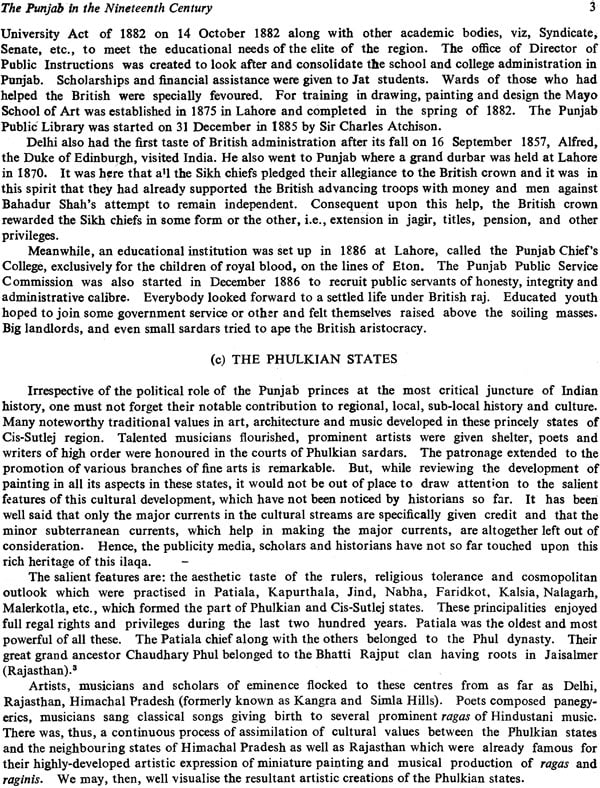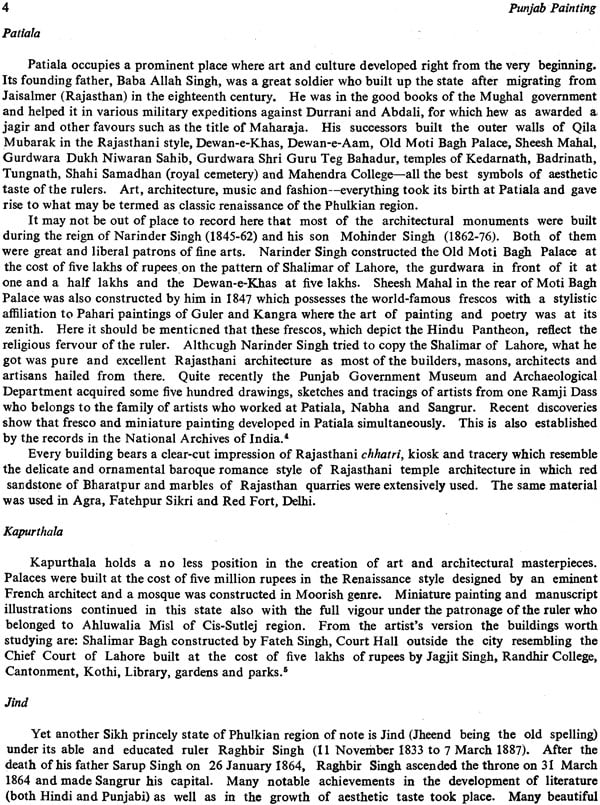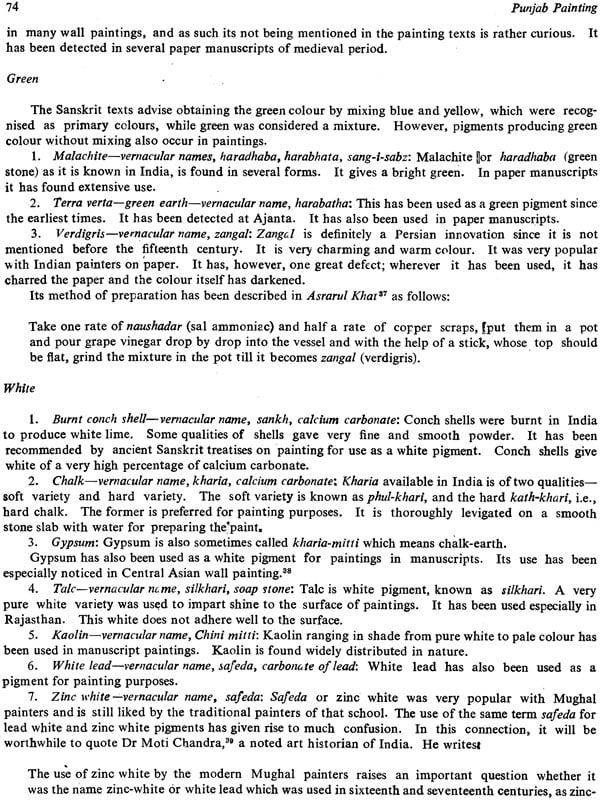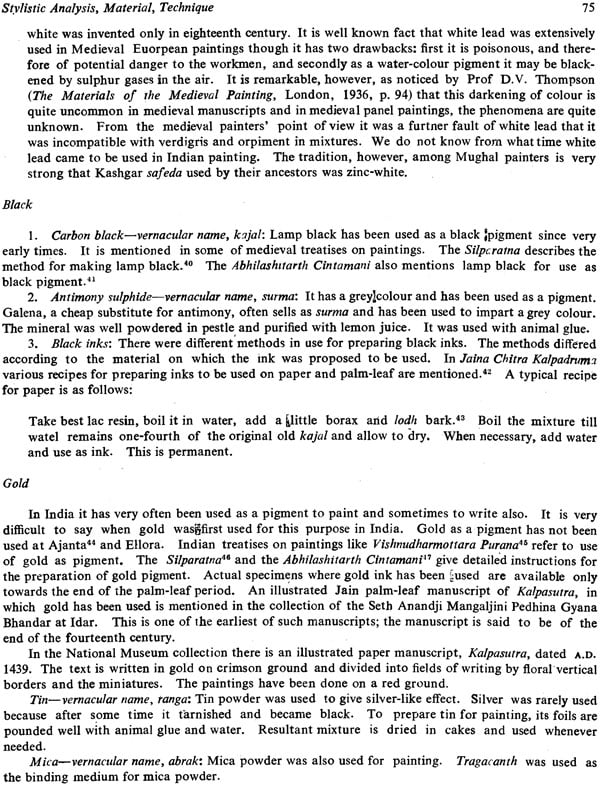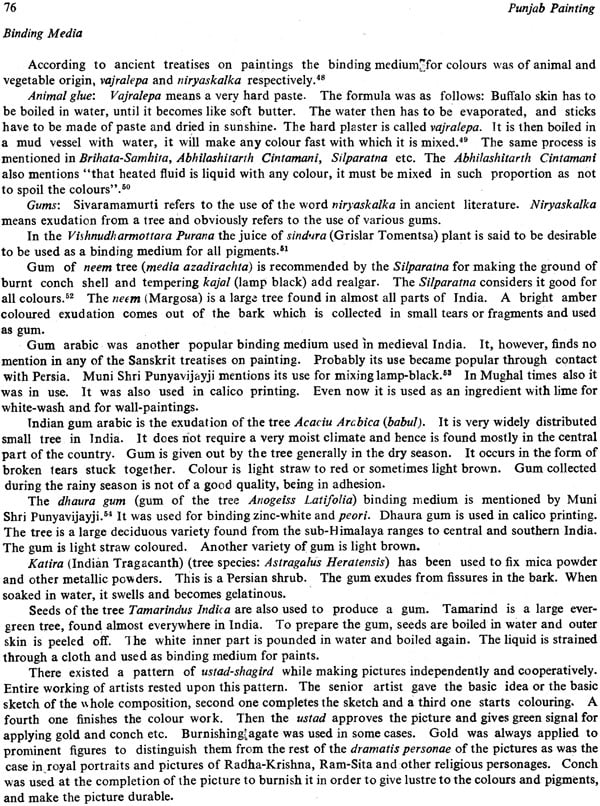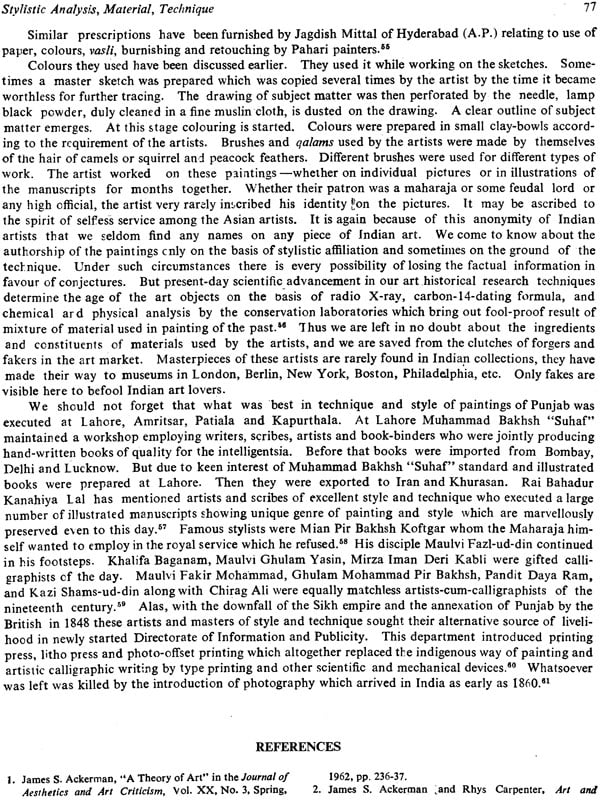
Punjab Paintings (Study in Art and Culture) (An Old and Rare Book)
Book Specification
| Item Code: | IDJ994 |
| Author: | R. P. Srivastava |
| Publisher: | ABHINAV PUBLICATION |
| Language: | English |
| Edition: | 1983 |
| ISBN: | 0391025600 |
| Pages: | 243 (Throughout Color and B/W Illustrations) |
| Cover: | Hardcover |
| Other Details | 11.0 inch X 8.5 inch |
| Weight | 980 gm |
Book Description
From the Jacket
'Painting in Punjab' is a doctoral thesis approved by Meerut (India). It is a first comprehensive survey of visual arts (miniature painting, illustrated manuscripts and mural painting) which flourished in the land of Five Rivers governed by the Lion of Punjab, Maharaja Ranjit Singh (1780-1839) as also the area reigned by East Punjab Rajas known as rulers of Cis-Sutlej i.e. Malwa state; Maharaja Narinder Singh (1845-1862) being the prominent among the patrons of art and learning whose contribution excelled all in this respect. The present study covers miniatures, illuminated manuscripts as well as the mural painting done in both the areas of Punjab thus discovering and establishing for the first time a definitive movement of visual arts, which existed in Punjab of nineteenth century.
This brings to the attention of scholarly world a rich style of painting known as 'Punjab Painting' hitherto unknown just like other Indian schools of painting viz Mughal, Rajput and Pahari painting with all the salient features of any art movement inherent in it. Special feature of the book lies in the fact that it sheds light on the social life of the painters who made creative and beautiful environments-royal and private both-but thus far remained in oblivion. Samultaneously it seeks to trace the presence of famous artists in both regions and their family genealogies which help us to track down the movement of art from one princely center to another.
One such family was Chughtai family which came from Heart (Persia) and settled in Lahore, and its members were responsible for significant contribution to creative arts of Punjab specially during the life time of Mahraja Ranjit Singh in the capital town of Lahore.
Unique feature of the book is that it offers to the reader an opportunity to see the flowering of Vaishnavite art in the courts of tolerant Sikh rulers of both trans-Sutlej as well as Cis-Sutlej areas of Punjab.
About the Author
Born 1932 at Roorkee (U.P.), M. A., Ph. D, in History of Art with title "Painting in Punjab: Study in Art and Culture" from Meerut University, Meerut. Edited special issue to The Sikh Sansar, Red-wood City (Calif.) U.S.A., devoted to Sikh Art, in 1973-74; "Patronage of Fine Arts under the Sikh Rulers of Punjab" in 1973-74 in Indian Historical Review; "Painting in Punjab" in 1979-80 in the Sikh Courier London; "S.G Thakur Singh: An Artist of Two Generations" in The Sikh Courier in 1977, London; "Manuscript as a source of Cultural History of India" in Vishveshvaranand Indological Journal, Hoshiarpur; "Abdul Rahman Chughtai: An Asian Artist of Mughal Ancestry" in Orientations, Hong Kong; "Muslim Architects and Artists of Maharaja Ranjit Singh" in Islamic Quarterly, London; "Rare Vaishnavite Manuscripts at Patiala" in B.O.I.R. Annals (poona); "Sikh Painting or Sikh School of Painting: A Myth or Reality" in V.I. Journal Vol. XIX Pt I & II-June-December, 1981, Hoshiarpur; "Some Reflections on the New Evidence of Punjab Painting" in The Sikh Review, Calcutta, October 1982 Vol XXX No. 346; Regular contributor to The Sikh Courier, London, and The Review, Calcutta and many other journals of repute in India and abroad. Serving the Punjab Education Department for the last twenty-nine years. Now actively engaged in teaching and research at Postgraduate Department of Fine Arts of Government College for Women, Patiala affiliated to Punjabi University, Patiala (Punjab), with effect from 1974. Life Member, Bhandarkar Oriental Research Institute, Poona; Fellow, Royal Asiatic Society, London, England; Member-Asia, tic Society, Calcutta; Member, Indian Institute of Islamic Studies, New Delhi. Appointed UGC Visiting Fellow at Indira Kala Sangit University, Khairagarh (M.P.) 1983.
Field of Specialization: art and architecture of Punjab, Mughal painting and architecture, manuscript painting, art historiography, social background of Indian art.
Foreword
R. P. Srivastava in his Punjab Painting has presented a systematic and well, researched study of the art of painting in the undivided Punjab of the last century, specifically during the reign of Ranjit Singh and his immediate successors. He has given a thorough coverage to the murals, miniatures and manuscript illuminations assignable to the period. The work is more comprehensive than the previous publications in the field. For instance, it has included the paintings which were produced in the erstwhile cis-Sutlej States like Patiala, Nabha, Kapurthala and Faridkot. The author has made an intensive study of these paintings which have not so far received the attention they deserve. I agree with the main thesis of the author that notwithstanding the influence of the Pahari paintings of Kangra, Basohli, Guler and other Hill States (now included in Himachal Pradesh), the painting of the Punjab plains developed an idiom of its own and thus it was by no means an offshoot or extension of the Pahari painting as is held by some scholars. Srivastava has buttressed his contention by some literary material, hitherto unknown or little known.
Much labour has gone into the making of this work. The author has spared no pains to undertake extensive field-study and he has collected data from diverse sources. One of these sources pertains to the families of the artists. The information gathered from Sri Ramji Dass of Patiala, whose ancestors did paintings at Patiala, Nabha and Sangrur, belongs to a family of this genre and is very useful. The discussions of the principal artists and their families are thus meaningful and interesting. The chapters on the 'theme' and 'stylistic analysis, material and technique' give evidence of the diligence and critical acumen of the author. The appendices, particularly A, B and C, will prove to be of substantial help to the prospective researchers in the field. The bibliography is fairly exhaustive and the illustrations quite rich and representative.
Punjab Painting will be regarded as one of the most authoritative works in the field for many years to come. And I am confident it will be welcomed by scholars on Indian art in general and Punjab art in particular.
Preface
The present study is the outcome of research work done leading to the award of degree of Doctor of Philosophy of Meerut University, Meerut (U.P.). An attempt has been dame here to trace out a definite style of painting, including wall painting as also the manuscript illustration, which flourished in Punjab in the late eighteenth and the whole of the nineteenth centuries. Punjab in this context con-notes the kingdom of Ranjit Singh known as trans-Sutlej Punjab, as well as the region ruled by the Sikh chiefs of cis-Sutlej states.
Although earlier studies by Dr. A. K. Coomaraswamy J. C. French, N. C. Mehta, Dr. W. G. Archer, Dr Mulk Raj Anand, Dr M. S. Randhawa and Dr B. N. Goswamy have drawn attention to the state of painting in Punjab, they erroneously attribute the entire credit for the development of this phenomenon to Pahari painting. Nevertheless, it was, in fact, a continuous tradition in Punjab, with Lahore as the capital of all the rulers, right from the times of Mahmud Ghazni and the later sultans, reaching its zenith in the Mughal period and continuing even during the time of Ranjit Singh when we are fortunate enough to locate ample evidence-visual as well as documentary-to prove that the art of painting flourished here even before the conquest of Hill chiefs by the Sikh monarch. All this belies the statement that Punjab painting was an offshoot of Pahari painting. Some external influences, however, cannot entirely overlap local genius. Secondly, the development of visual arts in cis-Sutlej states has been altogether ignored by the earned scholars. This lacuna has now been filled by this study. Hence, this study establishes that Punjab painting (both trans- and cis-Sutlej regions), which had thus far remained a neglected part of the history of Indian art, has been a vitally important partner of the mainstream of national style. The label of "Bazar Style", which some scholars used to ascribe to it, can no longer be valid hereafter.
Apart from the above, an attempt has also been made to track down the movement of artists and their families at the centers of patronage of art and culture. It has helped us a lot in locating a particular style of painting which flourished at and traveled to several places like Lahore, Amritsar, Patiala and Delhi and vice versa. It is hoped that a long-felt need for a book on Punjab painting shall be fulfilled by this publication.
The active cooperation of the following scholars was always available to me: Professor (Dr) B. N. Goswamy (Head of the Department of Fine Arts, Punjab University, Chandigarh), the late Dr W. G. Archer, Dr (Mrs) Mildred Archer (London) through several useful letters, Prof. Joanna Williams (California), Prof. (Dr) J. E. Van Lohiveen-de Le Leuw (Amsterdam), Academician Boris J. Stavisky (Moscow), Dr R. Nath, Jaipur, Prof. (Dr) Heinz Mode (Halle, GDR), Prof. (Dr) Joachim Peuke (Halle, GDR), Prof. (Dr) W. H. McLeod (University of Ottago, Dunedin, New Zealand), Prof. (Dr) Napier Gerald Barrier (University of Missouri, Columbia, Missouri, USA), Dr J. C. Harle (Ashmolean Musem, Oxford), Prof. (Dr) G. Tucci (Rome), Prof. (Dr) H. Hartel (W. Berlin). Dr. Pushppal Singh (Patiala) helped me in deciphering some religious motifs in the paintings, Prof. G. S. Rahi assisted me in studies of Sikh scripture, the late Dr. B. N. Sharma, National Museum (Delhi), had helped me in several technical matters relating to the scholarly publication of the research work. Dr Kalyan Kumar Dasgupta of Department of Ancient Indian History, Culture and Archaeology, University of Calcutta, Calcutta, obliged me with valuable advice in the presentation of this publication. I do not have adequate words to express my grateful thanks to Mr. Arif Rahman Sahib Chughtai, Director, Chughtai Museum Trust, Lahore (Pakistan), who offered me his selfless services, records and other literature for my researches in this regard. I am also extremely obliged to the former Maharajadhiraj of Patiala, Capt. Amrinder Singhji, who placed at my disposal some of his rare collection of fine arts. Prof. Gopal Kirondiwal (Amritsar) ungrudgingly translated for me material from Rajasthani into Hindi. Prof. P. S. Sekhon prepared quite a few photographs for this work. Prof P. S. Arshi, Head of the Department of fine Arts, Government College for Women, Patiala, gave me substantial financial assistance and Mr. Rajeshwar Sahai Mathur was kind enough to go through the manuscript.
I am thankful to Dr. Jagjivan Mohan Walia, S. Mohan Singh and Dr. K. S. Kang for help in this work. Mr Raghbir Sayal did a marvelous work in typing out a clean manuscript for publication.
I cannot help mentioning here my indebtedness to my learned and illustrious supervisor Dr. P. C. Barua, Head of the Department of fine Arts, J. V. Jain Degree College, Saharanpur (U. P.), but for whose constant guidance and generous encouragement coupled with a humorous pat this work, perhaps, would not have seen the light of day. My son Sanjiv Srivastava has been a great help in the selection and arrangement of photographs for this project. My daughter Sangita also helped me in several other ways. This brief not would be incomplete if mention is not made of the silent sacrifices, in terms of time and money, of my wife Mrs Pushpa Srivastava, who had to bear the brunt of it for the last twelve years.
Lastly, I must express my heart-felt gratitude to Shri Shakti Malik of Abhinav Publications for accepting and publishing this book so well that it stands comparison with art books published in Italy or Germany.
| Foreword | ix | |
| Preface | xi | |
| Acknowledgements | xiii | |
| List of Coloured Transparencies | xv | |
| List of Illustrations | xvii | |
| I | The Punjab in the Nineteenth Century (Historical and Cultural Background) | 1 |
| II | Paintings in the Punjab-A Survey | 11 |
| III | Painting in Punjab-Themes | 25 |
| IV | Patrons and Artists | 41 |
| V | Stylistic Analysis, Material, Technique | 60 |
| VI | Place of the Painting in Punjab in the Field of Indian Painting | 80 |
| Bibliography | 83 | |
| Appendices | 86 | |
| Index | 115 |


